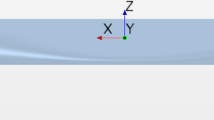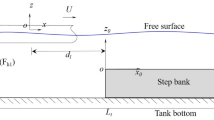Abstract
To evaluate the unsteady motion in laterally berthing maneuver, it is necessary to estimate clearly the magnitudes and properties of hydrodynamic forces acting on ship hull in shallow water. A numerical simulation has been performed to investigate quantitatively the hydrodynamic force according to water depth for Wigley model using the CFD (Computational Fluid Dynamics) technique. By comparing the computational results with the experimental ones, the validity of the CFD method was verified. The numerical solutions successfully captured some features of transient flow around the berthing ship. The transitional lateral force in a state ranging from the rest to the uniform motion is modeled by using the concept of circulation.
Similar content being viewed by others
References
Chen, H. C. and Korpus, R., 1993, “A Multiblock Finite-Analytic Reynolds-Averaged Navier-Stokes Method for 3D Incompressible Flows,”Individual Papers in Fluid Engineering, edited b F. M. White, ASME FED-Vol. 150,ASME Fluids Engineering Conference, pp. 113–121.
Chen, M. and Chen, H. C., 1996, “Numerical Simulation of Transitional Flows Induced by a Berthing Ship,”International Journal of Offshore and Polar Engineering, ISOPE, Vol. 7, No. 4, pp. 277–284.
Lee, Y. S., Sadakane, H. and Toda, Y., 2000, “Hydrodynamic Forces Acting on a Ship Hull Under Lateral Low Speed Motion,”Journal of the Japan Institute of Navigation, No. 102, pp. 87–95.
Miyata, H., Zhu, M. and Watanabe, O., 1992, “Numerical Study on a Viscous Flow with Free-Surface Water about a Ship in Steady Course by a Finite-Volume Method,”Journal of Ship Research, Vol. 36, No. 4, pp. 332–345.
Patel, V. C., Chen, H. C. and Ju, S., 1990, “Ship Stern and Wake Flows: Solutions of the Fully-Elliptic Reynolds-Averaged Navier-Stokes Equations and Comparisons with Experiments,”Journal of Computational Physics, Vol. 88, No. 2, pp. 305–336.
Smagoriksky, J., Manabe, S. and Hollowya, J. L., 1965, “Numerical Results Form a Nine-Level General Circulation Model of the Atmosphere,”Monthly Weather Review, Vol.93, pp. 727–768.
Sadakane, H., 1996, “A Study on Lateral Drag Coefficient for Ship Moving Laterally from Rest,”Journal of the Japan Institute of Navigation, No. 95, pp. 193–200.
Tahara, Y., 1993, “Computation of Viscous Flow around Series 60 Model and Comparison with Experiments,”Journal of The Kansai Society of Naval Architects, No. 220, pp. 29–47.
Takakura, Y., Ogiwara, S. and Isiguro, T., 1989, “Turbulence Models for Transonic Viscos Flow,”AIAA paper, 89–1952 CP.
Author information
Authors and Affiliations
Corresponding author
Rights and permissions
About this article
Cite this article
Kong, GY., Lee, YS. & Lee, SM. A study on the modeling of transitional lateral force acting on the berthing ship by CFD. KSME International Journal 18, 1196–1202 (2004). https://doi.org/10.1007/BF02983294
Received:
Revised:
Published:
Issue Date:
DOI: https://doi.org/10.1007/BF02983294




